
Nail psoriasis is a special form of psoriasis in which the nails of the hand and / or foot are affected. Doctors call this type of disease psoriatic onychodystrophy (Greek.onychos- nails,dys- infringement,trophe- food).
From this article, you can learn about the causes and symptoms of nail psoriasis, which do not always clearly indicate the correct diagnosis, as well as the dangerous misconceptions about this form of the disease.
Note.There are many photos in the article that can scare the unprepared reader.
Where do nails grow from?
To understand the problem of nail psoriasis, it is important to understand how a nail device works.
The nail has two functions: worker and aesthetic. First, the nail protects the fingertips from injury, increases accuracy and sensitivity when working with small objects, can be a weapon of attack or defense, and finally itches with the help of the nails. Second, the aesthetic or cosmetic function of the nails is also important, especially for women.
Nails are formed from the outer layer of the skin - the epidermis. The nail device includes:
- nail plate - directly on the nail itself,
- matrix - produces the nail plate,
- the nail hole or lunula is the only visible part of the matrix, it is a white moon-shaped area at the bottom of the nail plate,
- eponychium - nail roller that protects the matrix from damage from above,
- nail bed - located under the nail plate and is responsible for attaching the finger to the nail wall,
- hyponychium - the transitional zone between the nail bed and the skin of the fingertip.
Causes and mechanism of nail psoriasis
In doing so, with intermittent exacerbations and remissions, psoriasis on the nails is reminiscent of the vulgar form of the disease.
Nail psoriasis is thought to develop for the same causes and pattern as typical psoriasis outbreaks. Among these reasons, a distinction is made between external and internal factors.
The main internal factor is genetic predisposition. There are many external causes, such as injuries, poor diet, intoxicants (alcohol and tobacco), infections, and certain medications.
For these reasons, the usual mechanism of nail psoriasis can be briefly described as follows:
- Provocative factors such as trauma activate immune cells.
- Activated immune cells migrate to the area of the nail matrix or nail bed.
- Immunitis develops in these areas.
- The division of skin cells is sharply accelerated and their maturation is interrupted.
- There are characteristic symptoms of psoriasis on the nails.
In addition, the cause of nail psoriasis is the body’s inability to adapt to adverse environmental conditions. In this respect, the main cause of psoriasis is an evolutionarily alien habitat.
Consequently, this evolutionary approach considers unhealthy diet, lack of sun and clean water, excess toxins, lack of normal physical activity, sleep disorders, and chronic stress to be the direct causes of the disease.
Nail psoriasis and psoriasis are associated with arthritis
The link between nail damage and psoriasis arthritis has long been known.
Based on observations, the scientists found that psoriatic arthritis was associated with nail damage in nine out of ten cases.
But the mechanism of this relationship has not been fully investigated. The authors of several studies, for example from the Institute of Molecular Medicine in Leeds (UK), have tried to explain this relationship beyond the concept of immune inflammation.
In their view, the fact is that the finger joint is located next to the nail and is anatomically related to it.
Therefore, microtrauma and the Kebner phenomenon that causes primary arthritis - arthritis of psoriasis - also cause secondary pathological changes in the nearest nail.
This is why arthritis of psoriasis is so often associated with nail damage.
.jpg)
Thus, the symptoms of psoriasis of the nail often indicate arthritis of the psoriasis.
Now let’s look at the main myths that accompany this disease and how dangerous they are.
Myth 1: Nail psoriasis is rare.
Not really. Obviously, with psoriasis, the nails suffer very often.
According to various sources, nail psoriasis ranges in 6-82% of cases of vulgaris psoriasis. Such a widespread prevalence in the assessment of pathology prevalence is explained by accounting problems. Medical statistics primarily record the visits of patients in vulgar form to doctors, and secondly, they pay attention to nails. In scientific research, cases of nail psoriasis are usually examined only in addition to the main subject of interest - psoriasis with skin changes.
However, many publications say so
recurrent nail damage was reported in 80-90% of patients with psoriasis vulgaris.
And also that nail psoriasis occurs in 90% of patients with psoriasis arthritis and scalp psoriasis.
It should be noted that adults usually suffer from this form of the disease.
According to various sources, in children, nails are affected in about 7-37% of cases of psoriasis. Unfortunately, often the manifestations of psoriasis on a child’s nails are not given enough significance. Parents or doctors believe that this version of the norm is either a consequence of trauma or simply not noticed because of the mild severity of the symptoms.
Myth 2: Nail psoriasis is easy to recognize based on symptoms
In fact, not always. The fact is that
the nail is only able to respond to various diseases with a limited number of symptoms. Therefore, the manifestations of different diseases on the nails may look the same.
Of course, nail psoriasis can be suspected if the patient has severe vulgaris symptoms. However, nail lesions can be smaller than skin lesions and can be easily ignored by a doctor.
In general, the more active the psoriasis is on the skin, the more severe the nail damage.
First, the nails are affected.
And it’s also important to know that in 5% of cases, the nail may be the only initial manifestation of psoriasis. That is, the classic manifestations of psoriasis on the skin may be completely absent.
The appearance of psoriasis of the nail depends on where the pathological changes come from - in the matrix or bed of the nail.
The source of the symptoms - the matrix or the bed - is important to consider when choosing a treatment. It must therefore be defined correctly.
Symptoms resulting from the nail matrix:
- thymic symptom
- white spots and dots (leukonychia),
- red dots on the hole,
- crumbling nails.
Although the cause of these symptoms is at the matrix level, as the nail grows, acne changes appear on the nail plate.
The symptoms that are caused by the nail bed are as follows:
- nail detachment (onicholysis),
- longitudinal bleeding,
- subungual hyperkeratosis,
- symptom of oil slick.
We will then cover each symptom separately. And let’s start with the manifestations that emerge in the matrix.
Symptom of throat
The symptom of the thimble appears with holes or pits on the surface of the nail plate that appear as depressions in the thimble.
Such defects occur mainly on the nails, but rarely on the feet. As the nail grows, the pits move from the nail drive to the edge of the nail plate.
The pits in the psoriasis of the nail are usually deep, large and chaotic. They are formed from the surface of the nail due to the prolongation of loose groups of cells in which division and keratinization are impaired.
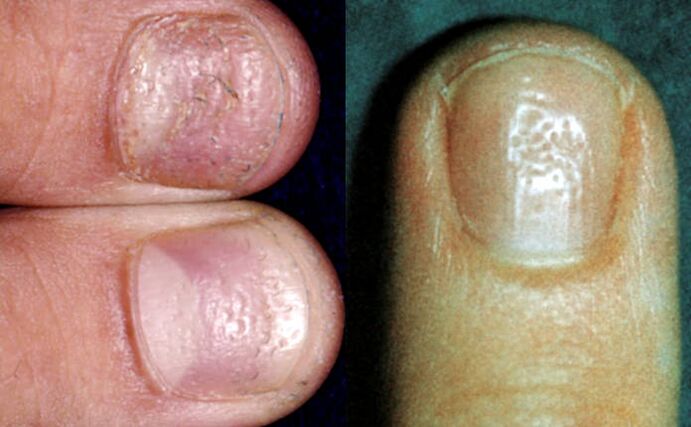
The more severe the psoriasis, the more often the thymic symptom occurs.
It should be borne in mind that in addition to psoriasis, the pits on the nails are also features of alopecia areata (alopecia), eczema, dermatitis, and can also occur with fungal infections, for example.
Counting the total number of pits on all your nails will help you make the right diagnosis.
- Less than 20 - not typical of psoriasis,
- 20 to 60 - psoriasis is suspected,
- more than 60 - confirm the diagnosis of psoriasis.
White spots (leukonychia)
Leukonychia is a symptom that manifests as white spots or dots on the nails.

With leukonychia (in Greek).leukóswhite andonychos- nails), in contrast to the surface pits that appear in the symptom of the thimble, cells with damaged division and keratinization are located in the thickness of the nail plate. However, the surface of the nail remains smooth. The white color of the spots is due to the reflection of light from sets of loosely located cells.
However, some studies suggest that leukonychia is so common in healthy people that it is not a characteristic symptom of psoriasis. For example, a manicure injury can cause leukonychia.
Crumbling nails
When the superficial pits (throat symptom) and the deep leukonychia zones (white spots) merge, the nails begin to crumble.

Typically, nail decay occurs with long-term nail psoriasis.
And the more intense the inflammation of the nail matrix, the more the nail plate is destroyed. In severe cases, the nail may completely collapse and fall out.
Red dots on the nail holder
Apparently there are red spots in the area of the hole and its general redness due to an increase in blood flow to the blood vessels under the nail.
Red dots are also formed in the hole due to damage to the structure of the nail plate: it becomes more transparent and thinner. As a result, on the one hand, the blood vessels become more visible, and on the other hand, the thin nail plate puts less pressure on the vessels underneath and fills with blood more.

Thinning of the nail plate can also cause redness of the entire nail bed.
Nail detachment (onicholysis)
Now consider the symptoms that are the source of the nail bed.
Onicolysis is the detachment of the nail plate from the bed due to the accumulation of cells below the nail by damaged division and keratinization.

Oncholysis itself (from the Greek language).onychosnails andλύσιςseparation) is not necessarily a sign of psoriasis and may develop as a result of, for example, a nail injury.
Initially, the loss of contact between the nail and the bed occurs in the hyponychia zone - along the outer edge of the nail plate. The onycholysis then propagates in the form of a semicircular line to the nail drive. The exfoliating area will become white due to the accumulation of air under the nail.
The reddish border (scientifically erythema) that develops along the edge of the onycholysis, which is usually seen on the fingers, is characteristic of psoriasis and helps to make a correct diagnosis.
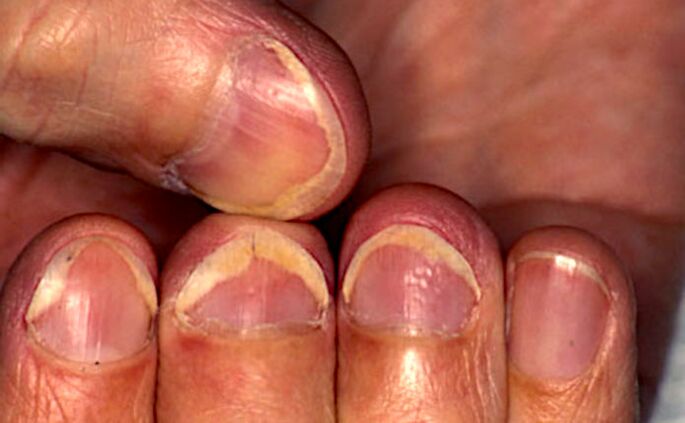
With prolonged onycholysis, the nail bed loses its properties, and growing new nails are unlikely to be able to fix normally. Therefore, onicholysis often occurs even when the nail plate is completely renewed.
Due to the fact that onycholysis facilitates the penetration of bacteria and fungi, the infection can join. This sometimes leads to discoloration of the nail. For example, a greenish color may occur when bacteria bindPseudomonas aeruginosa(Pseudomonas aeruginosa) and others.
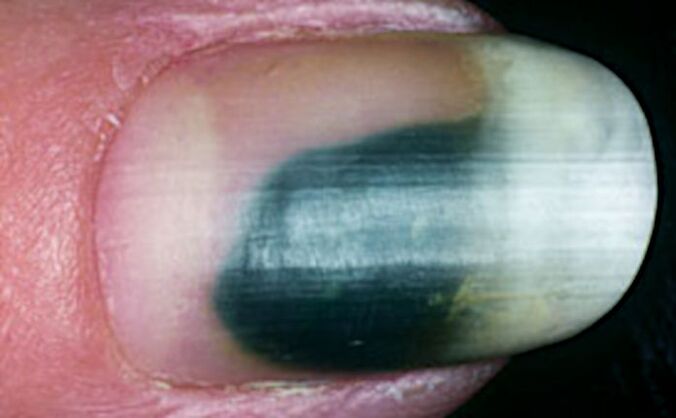
Longitudinal subungual bleeding
Longitudinal subungual hemorrhages occur in the nail bed, appearing as dark red lines 1-3 mm long.
Increased blood flow and edema in the area of inflammation of the nail bed lead to rupture of the capillaries, which manifests itself in the form of such bleeding.
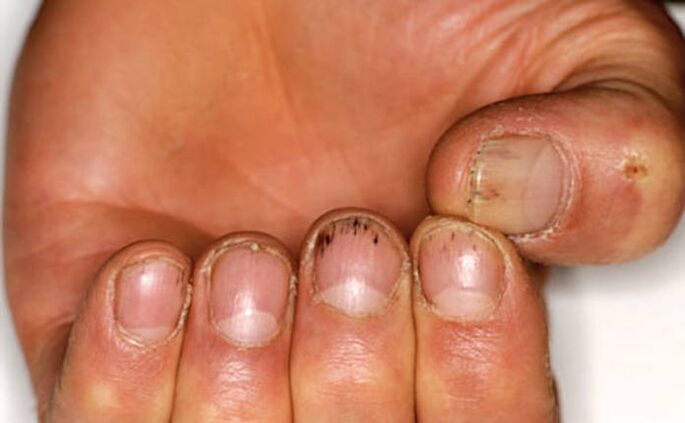
Due to the nature of the blood supply, most bleeding is closer to the free edge of the nail - the zone of hyponychia.
Subungual hyperkeratosis
Subungual hyperkeratosis is the accumulation of dead cells under the outer part of the nail plate.
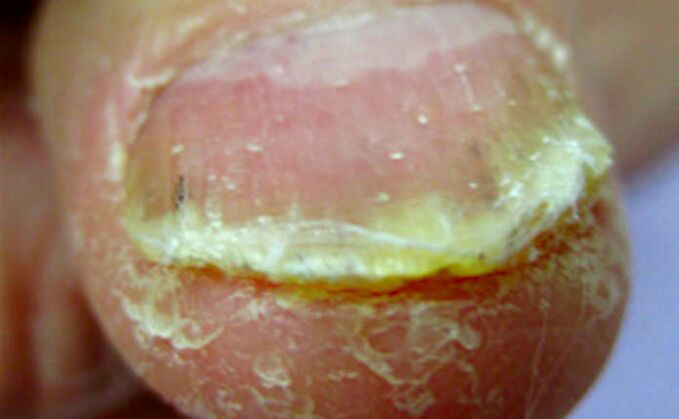
With psoriasis, subungual hyperkeratosishyperexcessively andkerashorn) is usually silver - white, but may be yellow. And when the infection joins, it can turn greenish or brown, for example.
The more the nail rises above the nail bed, the greater the activity of the pathological process.
On the fingers, subungual hyperkeratosis usually manifests in loose layers under the nail plate. On the legs, these masses are soldered tightly with thickened nails.
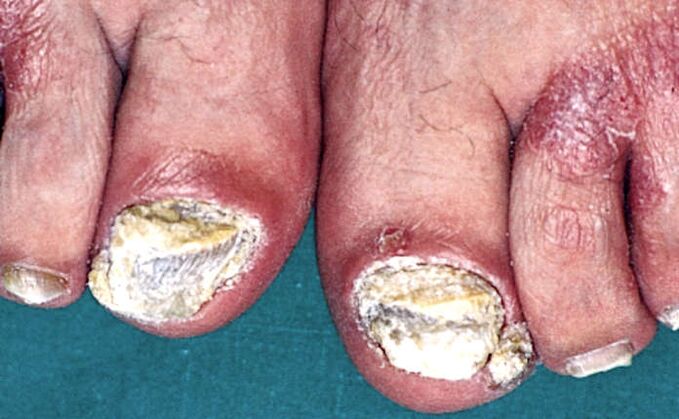
Psoriasis with toenails lesions is also characterized by a combination of subungual hyperkeratosis and onycholysis (nail separation).
Oil stained symptom
The symptom of an oil stain appears in yellow-red (salmon) spots under the nail plate.
They form on the nail bed closer to the nail fold and grow towards the edge of the nail.
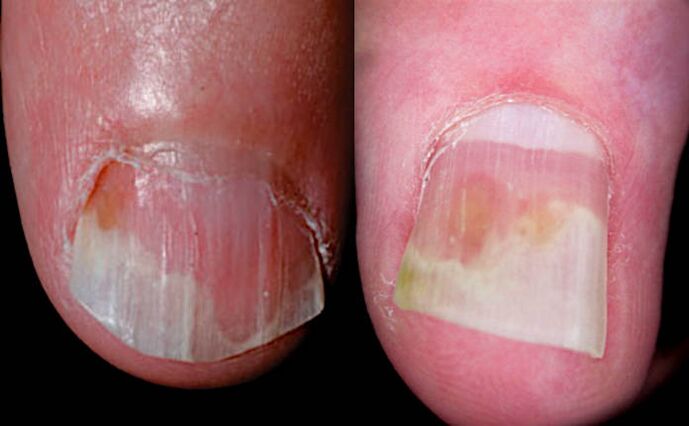
This symptom is caused by inflammation of the nail bed with dilation of the capillaries and accumulation of cells involved in the inflammation, as well as cells with damaged division and keratinization.
Oil stains are available in a variety of shapes and sizes. They can be found both in the middle and at the edge of the nail, next to the onicholysis zone.
Myth 3: Nail psoriasis is just a cosmetic problem.
In fact, this is not true. Although more than 90% of patients have reports of nails associated with unreported nasty psoriasis, this is not just a cosmetic issue.
According to various studies, nail psoriasis significantly impairs the quality of life of patients:
- 52% of patients also complain of pain,
- 59% - for problems of daily activities,
- 56% - home difficulties and
- 48% - in case of difficulties at work.
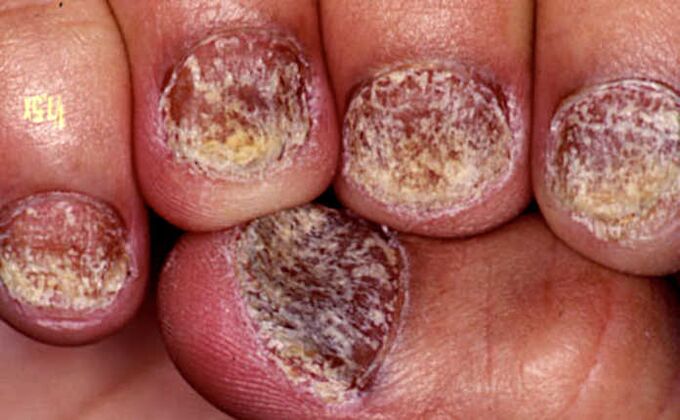
Therefore, it is very important to make a correct diagnosis and start treatment as soon as possible, as improving the condition of the nails will significantly improve the quality of life of patients with psoriasis.
Myth 4: Nail psoriasis is not dangerous
In reality, this is not the case. Speaking above about the causes of this form of the disease, we have already written about it
nail psoriasis is an important symptom of psoriasis arthritis.
It is important to keep in mind that external manifestations of arthritis may be completely absent. In this case, not only can we talk about the joints of the fingers and toes being affected, but also the joints of the bones of the spine and pelvis.
You can use ultrasound (ultrasound) or magnetic resonance imaging (MRI) to check your joints for arthritis.

Even if there are no obvious symptoms of arthritis but there are manifestations of nail psoriasis, it is very important to make sure that all joints are okay.
Then check the condition of the joints regularly. Otherwise, arthritis of psoriasis can be easily missed! Late diagnosis leads to late treatment and consequent irreversible joint damage and disability.
Therefore, if your doctor has not ordered insurance-related research, citing the lack of visible signs of arthritis, you should contact the clinic yourself and undergo, for example, a paid ultrasound scan.
How to diagnose nail psoriasis
It is important to be able to recognize many of the symptoms of nail psoriasis that have been described above as they help in making the correct diagnosis. But because the nail changes characteristic of psoriasis can also occur in other diseases, it can be difficult to make a correct diagnosis immediately.

In this case, the presence of multiple symptoms of multiple nails at once may help establish the diagnosis.
Important signs of psoriasis on the nails:
- thymic symptom: more than 20 pits on all nails of the hand indicate the possibility of psoriasis and more than 60 pits confirm the diagnosis of psoriasis,
- onycholysis with a reddish border on the edge,
- oil (salmon) stains on the nail bed.
Difficulties in diagnosing nail psoriasis with a single symptom
It is especially difficult to diagnose nail psoriasis if it is accompanied by only one symptom.
For example, if only onicholysis of the hands or only subungual hyperkeratosis of the arms and / or legs occurs.
The only way to make a reliable diagnosis of isolated onycholysis (nail detachment) is probably to examine hyponychia with a special microscope - a dermatoscope.
A high magnification video dermatoscope is used for this. Please note that the hand-held dermatoscope does not provide the required magnification. A video dermatoscope with a magnification of at least 40 times is required. The dilated capillary loops characteristic of psoriasis then become visible.
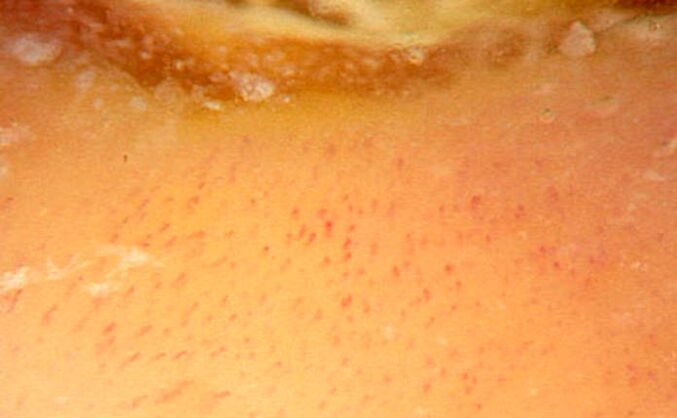
In isolated subungual hyperkeratosis, the likelihood of psoriasis is high if the accumulation of scales under the nail is whitish-silver in color and if all the nails of the hand or foot are affected.
Psoriasis or nail fungus?
About 30% of patients with nail psoriasis also have a fungal infection - scientifically onychomycosis.
Externally, hyperkeratosis and onycholysis (separation of the nail) in psoriasis may resemble manifestations of fungal infection. Therefore, it can be difficult to perform differential diagnostics, i. e. , to identify the real cause of nail plate changes.
Moreover, both psoriasis and fungus can affect the same nails at the same time. It most commonly occurs on the toes and is primarily characteristic of older patients.
In the case of a fungal infection, one or both nails of the big toes are also often affected. Psoriasis usually affects several nails at once.
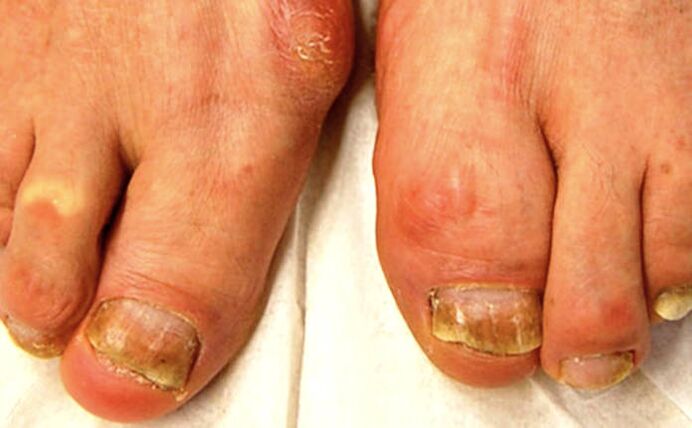
The following symptoms are associated with psoriasis:
- symptoms of oil stains and / or fingernails,
- signs of psoriasis on the scalp and / or large skin wrinkles,
- intermittent remission and worsening of nail damage.
They are in favor of onychomycosis:
- longitudinal stripes on the affected nail,
- detection of fungi by microscopic examination of potassium hydroxide-treated scraping of the affected nail (KOH test),
- positive culture of the fungus.
In general, it is impossible to completely rule out fungal nail infection in patients with psoriasis based on external manifestations alone.
It should also be recalled that a fungal infection can cause the Kebner phenomenon on the nails and surrounding skin, which can cause psoriasis symptoms. So definitely
it is helpful to go to a mycologist and do a test on the fungi and if found, start antifungal treatment.
Important findings and actions
We summarize important information about nail psoriasis and its symptoms.
Diagnostic features:
- Nail psoriasis is very common but often absent.
- The manifestation of psoriasis of the nail may be less severe, so even experts do not pay attention to it.
- In 5% of cases, nail damage may be the only symptom of incipient psoriasis.
- Manifestations of different diseases on the nails may look the same, which further complicates the diagnosis.
The main manifestations of nail psoriasis are:
- throat symptom - pits on the nail,
- white dots,
- crumbling nails
- red dots in the hole area,
- detachment of the nail,
- longitudinal subungual bleeding,
- subungual hyperkeratosis - loose clusters under the nail,
- symptom of oil slick.
Psoriasis and fungus:
- Nail psoriasis is often accompanied by a fungal infection.
- To clearly rule it out, you should contact a mycologist and do more research.
Nail psoriasis and psoriasis arthritis:
- Nail psoriasis is a common companion to arthritis of psoriasis.
- In order to start treatment on time and to avoid irreversible complications and disability, it is important to recognize abnormal changes in the joints as soon as possible.
- Even if the arthritis has no external symptoms but nail psoriasis is detected, the joints should be examined using ultrasound or MRI.























